


#Helpful syn plus#
Authorities have repeatedly recategorized the three populations of right whale plus the bowhead whale, as one, two, three or four species, either in a single genus or in two separate genera. Through the 1800s and 1900s, in fact, the family Balaenidae has been the subject of great taxonometric debate. The right whales were first classified in the genus Balaena in 1758 by Carl Linnaeus, who at the time considered all of the right whales (including the bowhead) as a single species. North Pacific right whale in Half Moon Bay, California, March 20, 1982, photo by Jim Scarff The earliest references to the right whale offer no indication why it was called that, and some who have studied the issue point out that the word "right" in this context might just as likely be intended "to connote 'true' or 'proper,' meaning typical of the group." However, this origin is questionable: in his history of American whaling, Eric Jay Dolin writes:ĭespite this highly plausible rationale, nobody actually knows how the right whale got its name. As a result, they were hunted nearly to extinction during the active years of the whaling industry.

They are quite docile and do not tend to shy away from approaching boats. Today, the North Atlantic and North Pacific right whales are among the most endangered whales in the world.Ī common explanation for the name right whales is that they were regarded as the right ones to hunt, as they float when killed and often swim within sight of shore. Although the whales no longer face pressure from commercial whaling, mankind remains by far the greatest threat to these species: the two leading causes of death are being struck by ships and entanglement in fishing gear. Right whales were a preferred target for whalers because of their docile nature, their slow surface-skimming feeding behaviors, their tendency to stay close to the coast, and their high blubber content (which makes them float when they are killed, and which produced high yields of whale oil). Gestation tends to last a year, and calves are Weaned at eight months old. During courtship, males gather into large groups to compete for a single female, suggesting that sperm competition is an important factor in mating behavior. They may forage the surface, underwater or even the ocean bottom. Right whales feed mainly on copepods but also consume krill and pteropods. In the Southern Hemisphere, right whales feed far offshore in summer, but a large portion of the population occur in near-shore waters in winter. In the Northern Hemisphere, right whales tend to avoid open waters and stay close to peninsulas and bays and on continental shelves, as these areas offer greater shelter and an abundance of their preferred foods. The warm equatorial waters form a barrier that isolates the northern and southern species from one another although the southern species, at least, has been known to cross the equator. Right whales are typically 13–17 m (43–56 ft) long and weigh up to 100 short tons (91 t 89 long tons) or more.Īll three species are migratory, moving seasonally to feed or give birth.
#Helpful syn skin#
The most distinguishing feature of a right whale is the rough patches of skin on its head, which appear white due to parasitism by whale lice. Right whales have rotund bodies with arching rostrums, V-shaped blowholes and dark gray or black skin. They are classified in the family Balaenidae with the bowhead whale. japonica) and the Southern right whale ( E. glacialis), the North Pacific right whale ( E. Right whales are three species of large baleen whales of the genus Eubalaena: the North Atlantic right whale ( E.


 0 kommentar(er)
0 kommentar(er)
